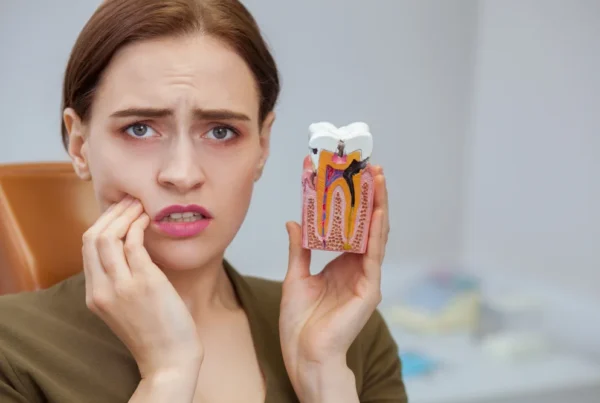Quick action following the loss of a filling or crown is critical to protect your dental health. An effective response comes from understanding why restorations are important and recognizing the immediate dangers posed by their absence.
Dental restorations such as fillings and crowns provide necessary protection to weakened teeth, helping to prevent further decay and maintain a healthy, functional bite. They act as a protective shield keeping underlying issues from returning and preventing potential new threats to the tooth’s strength.
When these protective barriers are lost, the exposed tooth is vulnerable to a host of issues. Without the restoration in place, the risk of infection increases, and the likelihood of tooth sensitivity or pain grows, possibly leading to more severe dental procedures if not addressed.
Understanding the full scope of these risks shows the urgency of seeking prompt dental care. It also informs the necessary steps you should take to minimize damage before professional help can be obtained, such as avoiding certain foods and using temporary protective measures.
Understanding the Critical Role of Fillings and Crowns
Dental fillings and crowns are essential to maintaining a healthy mouth; they shield teeth from decay and provide structural stability. When these defenses fail, the resulting risks call for swift and precise care to prevent pain, infection, and complex treatments.
Fillings and crowns do much more than repair dental decay; they also maintain the overall function of teeth. By sealing off vulnerable areas, they prevent bacteria’s access and eliminate core risk factors for further decay. Their role in preserving a tooth’s shape and ensuring a stable, healthy bite is fundamental to oral health.
Without the shield of a filling or crown, teeth are left defenseless against bacterial invasion. The immediate aftermath of losing a restoration can include increased sensitivity and pain, both signs of the tooth’s vulnerability to damage and infection:
- Loss of Protection: Exposed tooth structure becomes vulnerable to bacteria, food particles, and temperature changes
- Increased Sensitivity: Hot, cold, or sweet foods can cause sharp pain in the unprotected tooth
- Risk of Further Decay: Bacteria can easily enter the exposed area and cause additional damage
- Structural Weakness: The tooth may be more prone to cracking or breaking without its protective restoration
Understanding the consequences of restorative loss shows the necessity for prompt action. Once a restoration is no longer in place, seeking dental care becomes crucial, as the window to shield the tooth from further damage is narrow.
Your First Steps After Losing a Restoration
Immediate and well-informed action is essential when dealing with the loss of a dental restoration. The first steps taken after such an event can be critical, influencing the possibility of reattachment and the prevention of further complications.
Upon noticing the loss of a filling or crown, the most urgent task is to locate and safely store the restoration. This ensures the option for the dentist to examine and possibly reattach the original piece, saving time and resources in creating a new one. Clean the item gently and store it in a small container to protect it from contamination until the dental visit.
After the restoration is secured, the next step is to protect the now exposed tooth. Using available temporary over-the-counter dental products, such as dental wax or temporary filling materials, can provide a barrier against food particles and bacteria, which could otherwise further damage the tooth’s structure or cause infection.
Once the immediate threats to the tooth have been addressed, contacting a dental office should be the next priority. Communicating the situation to a dental professional allows them to provide specific guidance, arrange for prompt care, and plan the best approach to restoring the tooth’s health and function.
Why Home Remedies Have Important Limitations
Home dental remedies provide temporary relief but must be recognized for their limitations – they are not a replacement for a dentist’s expertise and can sometimes pose risks if relied upon for too long without professional consultation.
Simple over-the-counter solutions like dental cement are useful in easing the immediate discomfort caused by a lost filling or crown. However, they fall short of repairing the actual dental issue. These products temporarily seal the exposed areas, reducing sensitivity and providing short-term convenience, but they do not restore the tooth’s strength or structure.
While these home remedies can be effective in the moment, they are not capable of providing the permanent solution that a dental professional can offer. They act as a stopgap measure until proper care can be provided and should not be seen as a long-term fix. Failure to replace a temporary solution with professional treatment can lead to worsening dental conditions.
It’s important to use home remedies only as a temporary measure and to promptly seek professional dental care. Even when discomfort is relieved, without the correct treatment, the underlying issues causing the need for a filling or crown remain unresolved and could lead to more serious complications.
Taking Decisive Action to Protect Your Tooth
A decisive response to the loss of a dental restoration is essential to maintaining oral health and reducing potential damage. The actions you take should be deliberate and aimed at providing the tooth with the urgent care needed.
The initial step in addressing the loss of a restoration is safeguarding the affected tooth. This protection may involve rinsing the mouth to remove debris, applying temporary dental products to cover the exposed area, or simply avoiding chewing on that side to prevent further damage. These actions are temporary but necessary to maintain the tooth’s condition until a professional can deliver a permanent solution.
The urgency in consulting with a dental professional cannot be overstated. Timely communication with a dentist sets the course for a thorough assessment of the situation and a comprehensive solution:
- Immediate Protection: Rinse gently, apply temporary covering, and avoid using the affected tooth
- Professional Contact: Call your dentist immediately to explain the situation and get specific guidance
- Emergency Scheduling: Arrange the earliest possible appointment to prevent complications
- Pain Management: Use appropriate over-the-counter pain relievers as directed while waiting for professional care
The essence of taking decisive action lies in understanding that immediate, responsive care is as crucial as long-term treatment. Scheduling an emergency dental appointment is often the most critical step in the process.

Recognizing When You Need Urgent Care
Recognizing when to seek professional dental care is essential after a filling or crown is lost in order to prevent the occurrence of more serious complications.
Various symptoms signal the urgent need for dental intervention. Pain, often a telling sign, can quickly worsen as the exposed tooth comes into contact with different stimuli. Swelling, another red flag, might indicate potential infection requiring prompt treatment. When such symptoms arise, an immediate call to the dentist for assessment and care is essential.
Delaying dental treatment following the loss of a restoration can lead to more complex issues. A minor cavity under a lost filling can grow, potentially requiring a root canal or crown rather than a simple filling replacement. Delays may also lead to gum disease or tooth loss, dramatically escalating the required dental care level and associated costs.
Understanding which conditions require expedited dental care enables better decision-making for oral health. Conditions such as a sharp tooth edge causing tissue damage, or difficulty eating due to the lost restoration, should prompt immediate dental visits. Quick and accurate assessment can significantly improve outcomes and preserve dental health.
Getting Professional Assessment and Treatment
Consulting a dental professional is a vital step after losing a restoration to properly assess the damage, understand the repair options, and get advice on managing potential infection.
Every dental situation is unique, and only a dentist’s skilled assessment can determine the true extent of damage after a restoration loss. They can examine the affected tooth to identify issues such as cracks, decay, or susceptibility to further injury and discuss the most appropriate repair strategy to restore dental health.
An experienced dentist will present various treatment choices tailored to the condition of the lost restoration and the affected tooth. These options may range from reapplying the same crown or filling, if it’s still viable, to crafting and placing a new restoration entirely. Their advice ensures that patients receive the optimal solution for their oral health needs.
In situations where immediate in-office dental care isn’t an option, a professional can offer valuable advice on managing the problem at home. This might include recommendations for temporary protective measures or pain management techniques to use until the patient can receive proper dental treatment.
Preventing Future Restoration Loss
Preventive measures and careful dental practices are essential to minimize the likelihood of future restoration loss and ensure sustained oral health.
Consistent oral hygiene habits form the first line of defense in preserving dental restorations. Routine brushing and flossing remove plaque, a primary cause of decay that can compromise the strength of both fillings and crowns. By keeping the teeth and restorations clean, patients can significantly reduce the potential for restoration failure.
Periodic dental examinations allow for the early identification and treatment of problems that could threaten fillings or crowns. During these checkups, dentists assess the stability and condition of restorations, addressing minor issues before they escalate into major concerns that could require replacement or additional dental work.
Alongside daily hygiene and dental visits, following best practices such as wearing mouth guards during contact sports and avoiding overly hard or sticky foods protects restorations. Learning about such behaviors is a key aspect of preventive oral care, aimed at maintaining the longevity of dental work.
Don’t Wait – Protect Your Smile Today
A timely and informed response to the loss of a dental filling or crown is critical to reduce oral health risks and ensure functional recovery. This situation requires immediate attention to prevent complications and preserve the strength of the affected tooth.
At Dynamic Family Dentistry, we understand that losing a filling or crown can be both concerning and uncomfortable. Our experienced team is ready to provide prompt, effective treatment to restore your tooth’s protection and function while preventing further complications.
Don’t let a lost filling or crown lead to more serious dental problems. Contact Dynamic Family Dentistry immediately if you lose a restoration. Our emergency dental services are designed to provide the urgent care you need to protect your tooth and restore your comfort as quickly as possible.
Book Your Consultation Today!
Dr. Bethaney B. Brenner DMD
8 Milford St, Burlington, CT 06013
Frequently Asked Questions
What should I do immediately if I lose a filling or crown?
If you lose a filling or crown, it’s important to stay calm and protect the tooth. Rinse your mouth gently with warm water, and avoid chewing on the affected side. Call your dentist right away for advice and to schedule an appointment. Temporary dental materials can provide short-term protection, but nothing replaces professional care.
Should I see a dentist even if my tooth doesn’t hurt?
Yes, even if you don’t feel pain, an exposed tooth is at risk for further damage or infection. This can lead to more serious problems that are harder to treat. Contact your dentist as soon as possible to get the proper care you need.
How can I prevent my fillings and crowns from falling out?
Preventive steps such as regular brushing, flossing, and avoiding hard foods can help preserve your dental work. Regular dental check-ups are also crucial for catching potential issues early on and avoiding unexpected losses of fillings and crowns.
Related Articles





